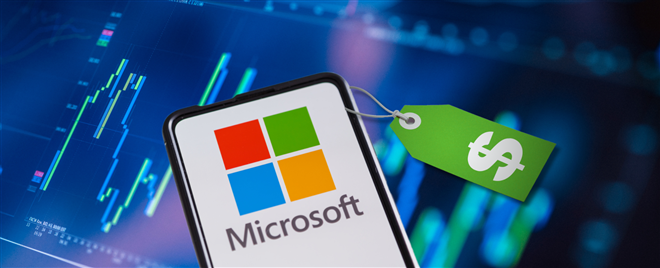Ticker Reports for November 27th
Microsoft Stock Gets a $550 Price Target: Time to Get Excited
Shares of Microsoft Corp (NASDAQ: MSFT) have been a cornerstone of tech portfolios for many years now, and 2024 has done little to tarnish that reputation. The stock is up a solid 15% year-to-date, and while it's struggled to push past July's all-time high, there are several reasons for investors to be excited.
Chief among these is the fact that analysts are exceedingly bullish on the tech titan's prospects heading into 2025. With the stock trading in a narrowing range, we could soon be looking at a breakout. Its shares are currently less than a 10% move away from July's high, so let's jump in and see what could send them soaring past it in the coming weeks.
Microsoft's Fundamental Performance Continues to Impress
For starters, there's the company's impressive fundamental performance. Microsoft has consistently beaten analyst expectations for its earnings for over two years, with this trend continuing with its most recent report at the end of last month. That report saw the company smash expectations for both headline numbers, with revenue growth standing out with a 16% year-on-year gain.
Investors should expect further gains heading into the rest of the year, as the holiday quarter historically tends to be Microsoft's strongest.
Bullish Analyst Updates Keep Microsoft in the Spotlight
Building on the fact that the internals are ticking over nicely, always a good starting point when considering a stock, is the fact that several analysts have been calling Microsoft a red-hot buy right. The teams at Royal Bank of Canada, UBS Group, and JPMorgan, to name just a few, have all reiterated their Buy ratings or equivalents in the past month alone. These updates echo a broader sentiment among analysts who have been consistently bullish on Microsoft throughout 2024.
Just last week, the Wedbush team doubled down on their bullish outlook for Microsoft, reiterating a Buy rating and a lofty $550 price target. From where the stock closed on Tuesday night, that's pointing to a targeted upside of nearly 30%. Needless to say, were Microsoft shares to hit that in the coming weeks, they'd be well above July's high and cruising into blue sky territory.
Potential Concerns: Analysts Reassess Microsoft Price Targets
While there is a lot of optimism about the stock, there are some notes of caution to consider. While maintaining their bullish ratings, some analysts have been reining in their price targets. For example, TD Cowen recently lowered theirs, citing higher capital expenditure forecasts. Still, the fact that they held off on doing a full downgrade from their Buy says enough about their confidence in the company's long-term prospects. Plus, even their revised $475 price target would have the stock trading at a fresh high.
For further counterbalance, it's worth noting that Morgan Stanley did the opposite with their price target on Microsoft shares and actually boosted it following last month's report.
Microsoft’s Technical Setup Suggests December Gains Are Likely
From a technical perspective, there's a lot to like as well. After months of steady consolidation and mostly sideways price action, the stock is now setting higher lows, a key indicator of building momentum.
Strengthening this thesis is the fact that Microsoft's MACD is on the verge of a bullish crossover, while its Relative Strength Index (RSI) is just 57. For context, the RSI is a popular technical indicator that measures the speed and magnitude of a stock's recent price changes to assess whether it is overbought or oversold. It runs on a scale of 0 to 100, with readings above 70 indicating overbought conditions and below 30 signaling oversold conditions. At 57, Microsoft's RSI suggests that momentum is firmly on the bull's side, and the stock has a lot of room to run before it could even be considered.
With the Fed cutting interest rates and broader indices like the S&P 500 currently at record levels, the macro environment also adds to the sense that a breakout to the north could be on the cards. Investors should look for the stock to continue setting higher lows into December, with a move above $440 all but confirming the breakout has begun.
⭕ [URGENT] Buy Alert just triggered
My absolute favorite stock just hit a critical "buy now" trigger price.
Click here for the ticker >>>Trump Tariffs in Focus: 2 Chinese Stocks to Own and 2 to Avoid
Donald Trump hasn't been shy about imposing tariffs when he returns to the White House in 2025. He has stated his intentions to levy 10% to 20% tariffs on imports and up to 60% to 100% tariffs on Chinese goods. Whether to take these statements literally or consider them negotiation tactics remains to be seen. The stock market isn’t taking any chances and is already pricing in the worst-case scenarios for Chinese stocks.
However, completely dismissing all Chinese businesses may be an overreaction, as some won't be impacted by additional tariffs. Here are two Chinese stocks that won't be affected, worth buying on the dips, and two Chinese stocks to avoid that will be impacted.
Alibaba: E-Commerce Stock to Avoid, Unless It Gets Too Cheap to Ignore
Investors in Chinese stocks have been on a rollercoaster ride as Chinese stocks surged on the new China stimulus hype and are now crumbling on Trump tariff fears. E-commerce giant Alibaba Group Holding Ltd. (NYSE: BABA) is a case in point. Its stock surged 38% from $85 to $117.82 on the hype driven by the China stimulus package in September, only to collapse to $83.13 on November 22, 2024, on a disappointing stimulus package ($1.4 trillion) and potential Trump tariffs.
How Much of Alibaba's Revenue Comes from the United States? At least 1%
Alibaba is known for its e-commerce and cloud computing businesses. Most of its e-commerce revenues come from China. However, its international revenue continues to grow annually. In 2024, Alibaba is expected to generate $60 billion in revenue from China and $14.1 billion internationally. In the first six months of 2024, Alibaba generated $29.34 billion in Chinese e-commerce revenue and $6.4 billion in international e-commerce revenue.
In Q3 2024, Alibaba generated total revenue of $33.7 billion. Chinese e-commerce revenue, primarily from Tmall and Taobao, totaled $13.5 billion, and international e-commerce revenue from the AliExpress and Trendyol platforms was $3.38 billion. The company doesn’t report totals by region. Alibaba.com is the B2B site that lumps it revenue in with the international segment.
An August 2023 Statistica survey indicated that 11% of AliExpress shoppers were from the United States. Assuming 11% of AliExpress’ Q3 revenue, or $371.8 million, came from the United States, that would amount to less than 1% of total quarterly revenue. This would result in a very minimal impact on Alibaba, but concerns of a 60% to 100% import tax can still keep the stock down. Additionally, there is no breakdown of how much U.S. revenues are generated through its B2B site. Sentiment often dictates price; therefore, consider avoiding it.
PDD Holdings: Temu.com Growth Makes This an Avoid
Chinese social e-commerce platform operator PDD Holdings Inc. (NASDAQ: PDD) saw that Pinduoduo was so successful that it launched an international version called Temu.com. Temu exploded in popularity in the United States thanks to unbelievably low prices, app gamification, social media influencers, and a marketing blitz.
According to ECDB, in 2023, Temu generated $6 billion in sales from the United States, which was 43% of its gross merchandise volume (GMV). It estimates that United States revenue will rise more than 50% in 2024. PDD generated $34.9 billion in total revenue in 2023. United States e-commerce sales accounted for 5.8% of total revenue. Temu has also gotten backlash about its app being a national security threat. The combination of tariffs and regulatory risk puts PDD Holdings on the avoid list.
JD.com: The Amazon.com of China Stays in Its Own Lane, The Chinese Market
So far, we’ve covered Chinese e-commerce businesses. JD.com Inc. (NASDAQ: JD) is the largest retailer in China, often referred to as Amazon.com Inc. (NASDAQ: AMZN) of China. JD.com primarily serves Chinese customers in China and internationally. They have warehouses in the United States to improve logistics when transporting items to Chinese customers in the United States.
JD.com's e-commerce businesses cater to Chinese customers, as they don't even have an official English version of their website. The prices are in yuan, and the descriptions are in Chinese. Alibaba has a larger international presence in this department. JD.com doesn’t indicate its revenue is split by region, so it’s best to assume they don’t generate any material e-commerce revenue from the United States. This is why its stock is behaving better than globalized Chinese e-commerce stocks. JD shares are trading up 20% year-to-date (YTD), PDD is down 31.6% YTD, and BABA is up 7.2% YTD. Due to a lack of meaningful US e-commerce revenue, JD.com shouldn’t be affected by Trump tariffs.
Li Auto: Selling Smart EREVs in China and Outside the United States
Chinese new energy vehicle maker Li Auto Inc. (NASDAQ: LI) is profitable and growing in China. The auto/tires/trucks sector company has found the right formula to address the major paint points of electric vehicles (EVs), range, and charging anxiety. Li Auto's extended range electric vehicles (EREV) also come outfitted with a motor that is used strictly to recharge the battery. This enables their EREVs, like its luxury L9, to drive up to 877 miles compared to 174 on battery alone. Drivers no longer have to worry about running out of power when driving an EV. The company just surpassed its one millionth vehicle delivery and continues to grow. Its first fully electric vehicle, the Mega, had a very lackluster reception, causing them to pause the launch of its second-ever EV until the latter half of 2025.
100% Tariffs Already Keep Li Auto Vehicles Out of the United States
Li Auto doesn't sell any of its vehicles in the United States due to the existing 100% tariffs on Chinese vehicles. The company doesn't plan on entering the United States markets but is making inroads into Europe. Any further Trump tariffs wouldn't impact Li Auto.
Bill Gates' is about to mint millionaires (again) with Stargate.
This little-known project that Bill Gates has been quietly working on that's about to unleash an AI breakthrough so advanced, it's going to make ChatGPT look like VHS.
But what's even more unbelievable?
I believe it'll make Nvidia's meteoric rise look like a backyard bottle rocket.
2 Generic Drug Stocks Ready to Surge in 2025
Generic and biosimilar drugs are often preferred over the brand name version due to their cheaper prices. Generics are exact duplicates of the branded counterparts, while biosimilars are "similar" and often require clinical trials. Health insurance companies, Congress, and patients love generics. It’s a growth industry in the medical sector as drug patents generally expire after 20 years after they are filed. The Trump administration is expected to streamline the U.S. Food and Drug Administration (FDA), which could result in faster approvals. Here are two generic drug stocks that will continue to grow in 2025.
Teva Pharmaceuticals: The King of the Generics Mountain
With a portfolio of over 500 generic drugs, Teva Pharmaceutical Industries Ltd. (NYSE: TEVA) is the world’s largest generic drug maker. Its generic drugs revenue surged 17% YoY, crushing the industry compound annual growth rate (CAGR) of 5.4%, as estimated by KPMG. Teva also develops its own branded drugs, including AUSTEDO for movement disorders, AJOVY for migraines, and UZEDY for treating schizophrenia, which are their growth engines. Teva produces a generic version of metformin, the world's most widely used drug for type-2 diabetes, as a first-line treatment to lower blood sugar levels.
Third Quarter Results Were Robust
In its third quarter of 2024 earnings report, Teva reported 66 cents per share, beating consensus estimates by 3 cents. Revenues grew 13% YoY to $4.33 billion, handily beating consensus analyst estimates of $4.14 billion. The company generated $693 million from operating activities and $922 million in free cash flow.
Teva’s Generic and Branded Drug Business Is Growing by Double-Digits
The generics business surged 30% YoY in the United States, 8% in Europe, and 13% in international markets. Its branded AUSTEDO revenues rose 28% YoY to $435 million. Teva reaffirms its 2024 revenue outlook of $1.6 billion. AJOVY revenue rose 21% YoY to $137 million. UZEDY's revenue continues to gain momentum, generating $30 million in the quarter as the company raises its 2024 revenue forecast to $80 million to $100 million. Teva submitted its generic version of Amgen Inc.’s (NASDAQ: AMGN) osteoporosis drug Prolia to the FDA and European Medicines Agency (EMA) for review.
Market Expected More Than In-Line Guidance
Teva issued in-line guidance for the full year 2024: EPS between $2.40 and $2.45 versus $2.30 to $2.50 consensus estimates. Full-year revenue is expected between $16.10 and $16.50 billion versus $16.27 billion analyst estimates. Adjusted EBITDA is expected between $4.7 billion and $5.0 billion. The company expects COPAXONE revenues of $500 million in 2024.
Teva Pharmaceuticals CEO Richard Francis commented, "I am confident that with our newly accelerated innovative pipeline, both early- and late-stage, we are well-positioned to provide meaningful access to medicines for patients who need them while also delivering continued growth for our shareholders.” He concluded, “With these strong results, we are raising our 2024 financial outlook, including revenues, Adjusted EBITDA, and Non-GAAP EPS.” Incidentally, Teva's stock fell 12% following the news.
Viatris: Merged Origins to Form a Leading Generics and Branded Pharma
Spawned from the merger of generic drug maker Mylan and Pfizer Inc.’s (NYSE: PFE) legacy business Upjohn in 2020, Viatris Inc. (NASDAQ: VTRS) is a leading generic, biosimilars and branded pharmaceuticals company with over 1,400 drugs in its portfolio. Its branded drugs include former blockbuster drugs from Pfizer that have since gone off patent, including cholesterol drug Lipitor, Viagra, antidepressant Zoloft, Lyrica, Influvac, and Norvasc for hypertension and chest pain. The company entered into an exclusive licensing agreement with Lexicon Pharmaceuticals Inc. (NASDAQ: LXRX) for INPEFA (sotagliflozin) in October 2024 to expand its cardiovascular diseases portfolio.
Falling Revenue Offset by Debt Reduction and New Revenue Growth
Viatris reported Q3 2024 EPS of 75 cents, beating analyst estimates by 7 cents. Revenues dropped 4.8% YoY to $3.75 billion, handily beating consensus estimates for $3.72 billion. Its portfolio of legacy blockbuster drugs continues to decline in revenue as expected, but its new drugs are growing in Emerging Markets, Europe, and China. Generics saw divestiture-adjusted growth of 4% versus 2% YoY growth in Branded drugs.
Viatris has been paying down its debt from $17 billion at the start of 2024 to a projected $14 billion by the end of the year. The company plans to return 50% of the free cash flow to shareholders and apply 50% for stock buyback upon achieving a 2.8x to 3.2x EBITDA range.
The company will be releasing EFFEXOR for anxiety and INPEFA for heart failure, which are highly anticipated growth drivers. The new products revenue forecast was raised from $500 million to $600 million by year's end. Shares surged 13% the following day after its earnings release.


![⭕ [URGENT] Buy Alert just triggered](https://www.marketbeat.com/images/webpush/files/thumb_2059push_Picture6.png)



0 Response to "🌟 Microsoft Stock Gets a $550 Price Target: Time to Get Excited"
Post a Comment